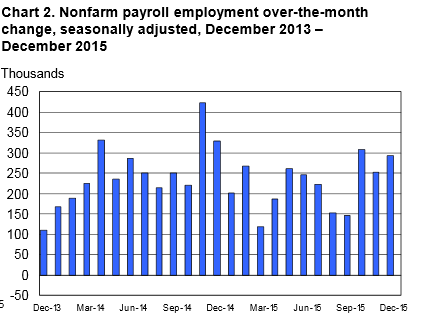January Employment Blog
This Employment Blog is from the Bureau of Labor Statistics U S Department of Labor. Nonfarm payroll employment increased by 292,000 in December, and the unemployment rate held at 5.0 percent. Job growth occurred in several industries, led by professional and business services, construction, health care, and food services and drinking places. Mining employment continued to decline. Incorporating revisions for October and November, whichincreased nonfarm payroll employment by 50,000, monthly job gains have averaged 284,000 over the past 3 months. In 2015, job growth averaged 221,000 per month, compared with an average of 260,000 per month in 2014. These trends are summarized in Charts 1 and 2 below.
Professional and business services added 73,000 jobs in December. Much of the gain occurred in temporary help services (+34,000). In 2015, employment in professional and business services increased by an average of 50,000 per month, compared with an average of 59,000 in 2014.
Construction showed strong job growth for the third consecutive month, gaining 45,000 jobs in December. Employment rose among specialty trade contractors (+29,000) and in construction of buildings (+10,000). Over the year, construction added 263,000 jobs, compared with a gain of 338,000 jobs in 2014.
Health care also continued to add jobs in December (+39,000), with gains in ambulatory care services (+23,000) and hospitals (+12,000). In 2015, monthly job gains in health care averaged 40,000, compared with an average of 26,000 in the previous year.
Employment in food services and drinking places increased by 37,000 in December. Over the year, the industry added 357,000 jobs.
Within information, motion picture and sound recording industries added 15,000 jobs in December, offsetting a decline in the previous month. In the transportation and warehousing industry, employment rose among couriers and messengers (+15,000).
Manufacturing employment changed little in December. In 2015, factory employment overall was little changed (+30,000), following strong growth in 2014 (+215,000).
Retail trade employment also changed little in December, following job gains in the previous 2 months. In December, job gains occurred in miscellaneous store retailers (+9,000), building material and garden supply stores (+9,000), and automobile dealers (+8,000). Employment in clothing and clothing accessories stores fell by 18,000 over the month. In 2015, retail trade added 274,000 jobs.
Mining continued to lose jobs in December (-8,000). Employment in the industry declined by 129,000 in 2015. During the past year, mining lost about half of the jobs that were added in the prior 5 years. Most of these gains and losses were in support activities for mining.
Average hourly earnings of all employees on private nonfarm payrolls were little changed in December (-1 cent) at $25.24, following a 5-cent increase in November. Over the past 12 months, average hourly earnings have risen by 2.5 percent. From November 2014 to November 2015, the Consumer Price Index for all Urban Consumers (CPI-U) was up by 0.4 percentage point (on a seasonally adjusted basis).
Turning to data from the household survey, the unemployment rate in December was 5.0 percent for the third month in a row. The number of unemployed, at 7.9 million in December, was essentially unchanged. Over the year, both the jobless rate and the number of unemployed were down, by 0.6 percentage point and 800,000, respectively. In December, 2.1 million of the unemployed, or 26.3 percent, had been jobless for 27 weeks or more.
The labor force participation rate, at 62.6 percent, was little changed in December and has shown little movement in recent months. The employment-population ratio, at 59.5 percent,also changed little over the month. Among the employed, the number working part time for economic reasons, also referred to as involuntary part-time workers, was little changed in December, at 6.0 million. The number of these workers was down by 764,000 over the year. (Involuntary part-time workers are those who would have preferred full-time employment but were working part time because their hours had been cut back or because they were unable to find full-time work.) Among people who were neither working nor looking for work in December, 1.8 million were classified as marginally attached to the labor force, down from 2.3 million a year earlier. The number of discouraged workers, a subset of the marginally attached who believed that no jobs were available for them, was 663,000 in December, little different from a year earlier. (The marginally attached are individuals who had not looked for work in the 4 weeks prior to the survey but wanted a job, were available for work, and had looked for a job within the last 12 months.)
Employment, unemployment rates and participation rates for 2015 are summarized in Table B below.



